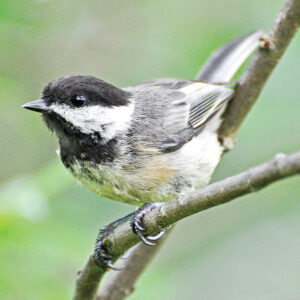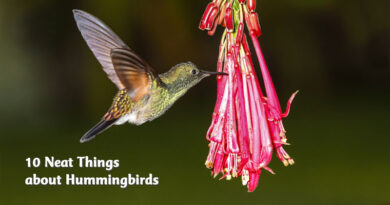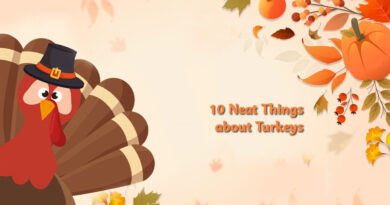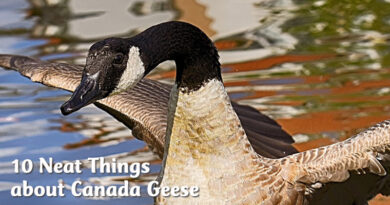My Li’l Chickadee
By Sherrie Versluis

For those who participate in feeding wild birds, there is no bird more adored than the black-capped chickadee. A bird filled with such a sense of sweetness that even the movies made them popular. In the early 1930s, actor W.C Field’s most famous line was calling a female character ‘My little chickadee’. This small, friendly little bird is a regular visitor at feeding stations and is revered for its interesting and communicative behaviour with those who fill the feeder. This makes the black-capped chickadee one of the most familiar and usually the first identified bird for people who take an interest in the hobby of birding.
Chickadees are often described as being ‘cute’ for many reasons. Their tiny little round body, with their sweet little voice and acrobatic ways as they flit in the trees really are cute as can be. The black-capped chickadee has a black cap and bib, a grey back and wings, with snow white cheeks. Their underside is white with buff colours along the edges of their belly. Both sexes look alike but males are somewhat larger than the female. Chickadees weigh about 14 grams and have a wingspan of just over eight inches. They are nonmigratory and are found in every province and all types of habitat from the deep woods to suburban areas.
Chickadees are cavity nesters choosing natural holes in trees as well as human provided housing. Nesting season begins in late April when the female constructs a nest of moss, bark, fine grass and even animal hair. Shortly after, six to eight eggs are laid and hatch in 11-14 days. During the incubation time the male works hard collecting and providing food for his mate and even more so once the chicks have hatched. The young will fledge the nest after a mere 12-16 days. Parents continue to feed the young for several weeks even though they are capable of catching their own food within one short week. Chickadees will have one to two broods per season depending on conditions.
Before winter sets in the young have dispersed into their own territories and winter flocks begin to form. Flocks consist of adults and new young that have moved into the area and can range in size from as small as six or eight up to 18. There is a notable hierarchy in flocks. Rank depends on age, body condition, singing, and reproductive success. A young bird’s rank is judged on their time of arrival; those that show up first tend to have higher status. The size of territory a flock will exist in is generally 15-20 acres but may reach up to 50 acres depending on food sources and habitat. Flocks provide winter benefits such as sharing body heat by roosting together at night, and more birds to seek out food sources and alert the group to potential predators.
Black-capped chickadees have one of the widest vocabularies for a songbird. Scientists have recorded and described 15 different calls from this one specie. Their calls vary including short little chips, whistles, and gargles, to their most recognized song described as chick-a-dee-dee-dee from which their name derives.
Chickadees eat a plentiful diet of seeds, caterpillars, insect eggs, larvae, and berries. During nesting time males can be seen with beaks filled with caterpillars all day long as he continuously feeds his family. Chickadees are truly a trees best friend as they eat many nuisance bugs that can be damaging to the health of a tree. To attract chickadees to birdfeeders consider filling them with black oil sunflower seed, shelled peanuts, suet, and shelled sunflower seed. They will eat from almost any birdfeeder but some favourites include window feeders, platforms, and smaller sized feeders that are not dominated by house sparrows. House sparrows can be very aggressive towards chickadees and other small birds which can deter them from visiting. You can put a birdfeeder up at any time of the year to attract your own ‘little chickadee’, enjoy!
Sherrie Versluis owns The Preferred Perch Wild Birds and Specialty Gift Store in Winnipeg, Manitoba.






